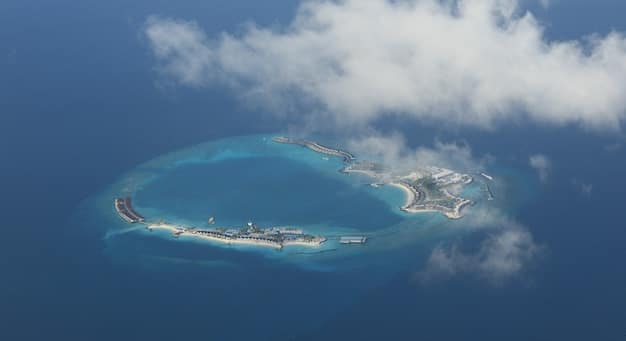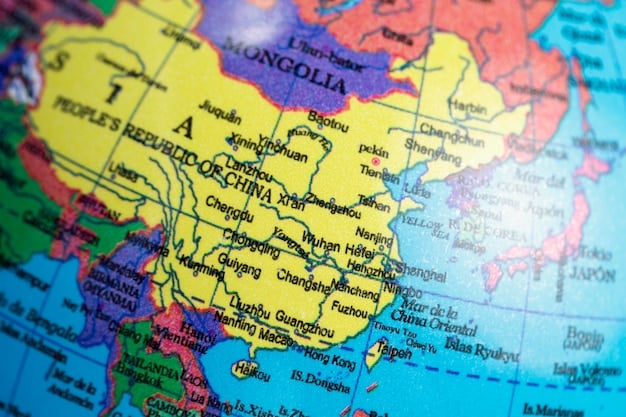South China Sea Tensions: Consequences for US Interests

Rising tensions in the South China Sea carry significant potential consequences for US interests, ranging from economic disruptions and military challenges to diplomatic strains and impacts on international law and regional stability.
The South China Sea, a vital waterway for global trade and resource-rich region, has long been a source of contention. Understanding what are the potential consequences of the rising tensions in the South China Sea for US interests is crucial for navigating the complex geopolitical landscape and ensuring American security and economic stability.
Navigational Freedom and Economic Impact
The South China Sea is a crucial artery for global trade, and the United States has a vested interest in maintaining freedom of navigation in the region. Escalating tensions could disrupt shipping lanes, impacting the US economy and global supply chains.
Maintaining Freedom of Navigation
The US has consistently asserted its right to conduct freedom of navigation operations (FONOPs) in the South China Sea, challenging China’s expansive territorial claims. These operations are intended to ensure that international waters remain open to all nations.
Potential Economic Disruptions
Conflict or heightened military activity in the South China Sea could significantly disrupt commercial shipping, leading to increased costs, delays, and potential shortages of goods. This would directly impact US businesses and consumers.
- Increased insurance premiums for ships transiting the region.
- Delays in the delivery of goods and raw materials.
- Higher prices for imported goods in the US market.
- Disruptions to global supply chains affecting US manufacturing.
The United States relies on the South China Sea for a significant portion of its trade with Asia. Disruptions to navigation could have cascading effects on the US economy.

Military and Security Implications
The rising tensions in the South China Sea pose significant military and security challenges for the United States. The US military maintains a strong presence in the region to deter aggression and protect its allies.
China’s Military Buildup
China’s construction of artificial islands and deployment of military assets in the South China Sea have raised concerns among neighboring countries and the United States. This buildup has altered the strategic landscape and increased the risk of miscalculation.
US Alliances and Commitments
The United States has treaty obligations to defend several countries in the region, including the Philippines and Japan. A conflict in the South China Sea could draw the US into a military confrontation with China.
- Increased military spending to maintain a strong presence in the region.
- Potential for accidental clashes or escalation.
- Strain on US military resources and readiness.
- Risk of miscalculation leading to broader conflict.
The US military faces the challenge of balancing its commitment to regional security with the need to avoid direct conflict with China. A delicate balance of deterrence and diplomacy is required.
Diplomatic and Political Ramifications
The South China Sea dispute has significant diplomatic and political ramifications for the United States. The US must navigate complex relationships with China and its allies in the region.
Relationship with China
The South China Sea issue is a major source of friction in the US-China relationship. Washington and Beijing have differing views on maritime law, territorial claims, and regional security.
Regional Alliances and Partnerships
The United States relies on its alliances and partnerships in the region to counter China’s growing influence. Countries like Australia, Japan, and South Korea share US concerns about China’s assertiveness in the South China Sea.
- Increased diplomatic efforts to resolve disputes peacefully.
- Strengthening alliances and partnerships in the region.
- Promoting international law and norms.
- Addressing concerns about human rights and democracy.
The United States seeks to build a coalition of countries that support a rules-based order in the South China Sea and oppose unilateral attempts to change the status quo.
Impact on International Law and Norms
The South China Sea dispute raises important questions about international law and the rules-based order. China’s expansive claims and actions in the region challenge established norms and treaties.
The United Nations Convention on the Law of the Sea (UNCLOS)
The United States, although not a party to UNCLOS, recognizes it as the primary legal framework for maritime issues. China’s interpretation and application of UNCLOS in the South China Sea have been widely criticized.
The Arbitral Tribunal Ruling
In 2016, an international arbitral tribunal ruled against China’s claims in the South China Sea. China has rejected the ruling, further undermining the credibility of international law.

- Promoting respect for international law and treaties.
- Supporting the peaceful resolution of disputes through arbitration and negotiation.
- Holding countries accountable for their actions in the maritime domain.
- Strengthening the role of international institutions.
The United States has a strong interest in upholding international law and norms in the South China Sea to ensure stability and prevent future conflicts.
Regional Stability and Security Dilemma
The South China Sea dispute contributes to a broader security dilemma in the Asia-Pacific region. Increased military activity and territorial disputes create a climate of mistrust and insecurity.
The ASEAN Factor
The Association of Southeast Asian Nations (ASEAN) has sought to play a role in managing the South China Sea dispute. However, divisions among ASEAN members have limited its effectiveness.
The Role of External Powers
Countries like India, Australia, and France have also expressed concerns about China’s actions in the South China Sea and have increased their engagement in the region.
- Promoting dialogue and cooperation among regional actors.
- Supporting ASEAN’s efforts to manage the dispute.
- Encouraging transparency and confidence-building measures.
- Addressing the underlying causes of instability.
The United States can work with its allies and partners to promote regional stability and address the security dilemma in the South China Sea through diplomatic, economic, and military means.
Resource Competition and Environmental Concerns
The South China Sea is rich in natural resources, including oil, gas, and fisheries. Competition for these resources has exacerbated tensions in the region and raised environmental concerns.
Energy Resources
The potential for oil and gas reserves in the South China Sea is a major driver of territorial disputes. China’s exploration and exploitation of these resources have been met with resistance from other claimant states.
Fisheries Depletion
Overfishing and destructive fishing practices have depleted fish stocks in the South China Sea, threatening the livelihoods of coastal communities and damaging marine ecosystems.
- Promoting sustainable resource management.
- Encouraging joint development agreements.
- Combating illegal fishing practices.
- Protecting marine biodiversity and ecosystems.
The United States can work with regional partners to promote sustainable resource management and address environmental concerns to reduce tensions and ensure the long-term health of the South China Sea.
| Key Point | Brief Description |
|---|---|
| 🚢 Navigational Freedom | Maintaining open shipping lanes is vital for US economic interests. |
| 🛡️ Military Buildup | China’s military expansion poses a direct challenge to US allies. |
| ⚖️ International Law | Upholding UNCLOS is essential for regional stability and US influence. |
| 🌍 Regional Stability | Tensions undermine regional security and create opportunities for conflict. |
Frequently Asked Questions
▼
The main dispute revolves around conflicting territorial claims by several countries, including China, Vietnam, the Philippines, Malaysia, and Brunei, over islands, reefs, and resources in the South China Sea.
▼
The South China Sea is crucial for the US due to its importance for global trade, freedom of navigation, regional security, and the protection of US allies and partners in the region.
▼
The US takes a neutral stance on the competing territorial claims but insists on the importance of resolving the dispute peacefully, in accordance with international law, and without coercion.
▼
A conflict could disrupt shipping lanes, increase insurance costs, and lead to delays in the delivery of goods, which would negatively impact US businesses and consumers, and disrupt supply chains.
▼
The US conducts freedom of navigation operations, strengthens alliances, engages in diplomatic efforts, and supports international law to address tensions and promote stability in the South China Sea.
Conclusion
The rising tensions in the South China Sea present a complex challenge for the United States, requiring a multifaceted approach that combines diplomacy, military deterrence, and economic engagement. By upholding international law, strengthening alliances, and promoting regional stability, the US can protect its interests.





